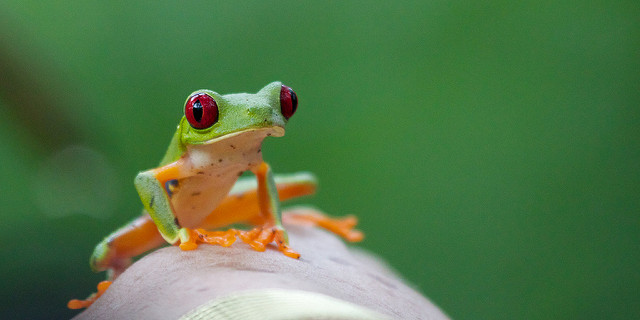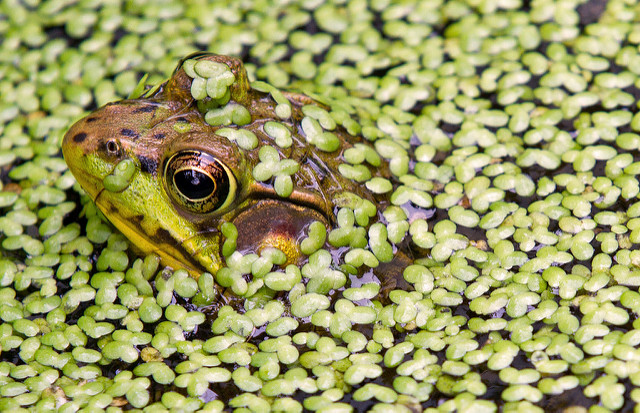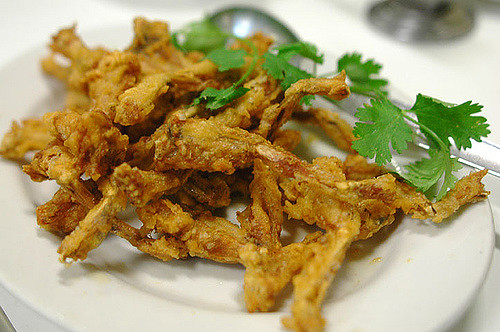A Frog in Every Pot
A frog likes water, but not hot water — Swahili proverb
You’ve heard it said that if you put a frog in boiling water, it will immediately jump out, but if you put it in cool water that you slowly bring to a boil, the frog won’t notice and will eventually die. It’s supposed to demonstrate how people often find themselves victims of tragic circumstances that are introduced incrementally—and they don’t realize it until it’s too late.
Whenever I hear this frog story, I think of two questions: 1) Is it true? and 2) Why in the world would you boil a live frog?
The answers should be simple, right? Well, think again.
German physiologist Friedrich Gotz comes close to answering both questions with experiments he conducted 150 years ago, publishing the results in 1869. According to the English philosopher, literary critic, and scientist George Henry Lewes, writing in Nature in 1873, Gotz was testing for the presence of a “spinal soul” in frogs. To that end, he placed a frog in water that was slowly heated. At 25º C (77º F), the frog “manifest[ed] uneasiness” and as the heat increased, “vainly struggl[ed] to get out.” This was in contrast to another frog, exposed to the same conditions, from which Gotz had previously removed its brain. As the water grew warmer, the brainless frog, while responding to other stimuli, “never once attempt[ed] to escape the impending death,” which came about at 56º C (132.8º F).
Put a tally down for “not true,” since the first frog would have gotten out if it had been allowed to, and the second one expired under less than normal circumstances.
In the years that followed, several scientists, in several countries, replicated Gotz’s experiments, with some verifying, and some contradicting his results. In his “On Variations of Reflex-Excitability in the Frog, Induced by Changes of Temperature,” MIT professor William Thomas Sedgwick gave a summary in 1888 of the research. He writes that J. Tarchanow (Russia, 1871) and M. Foster (England, 1873) show that normal frogs try to escape gradually heated water, while A. Heinzmann (Germany, 1872) and Carl Fratscher (Germany, 1875) show that a gradual increase in temperature results in the frogs’ death. Sedgwick concludes that the differences in results come down to the definition of “gradual.” While a gradual increase in the heat of the water may cause a frog to at least try to escape, a “sufficiently gradual” increase will not.
In a more modern look at the situation, in 1995, Fast Company consulted George R. Zug, curator of reptiles and amphibians at the National Museum of Natural History, and Harvard University Biology Department’s Doug Melton. The two agree that the science behind the boiling-frog metaphor is complete bunkum (with Zug using more colorful language). First, they say, frogs put in boiling water will not jump out, they will simply die (I’ve ignored this half of the scenario until now). Second, a frog won’t sit still long enough to be boiled in slowly heated water.
Australian science broadcaster Karl Kruszelnicki jumped in in 2011 with his own rebuttal of the yay-sayers. Not only does he quote University of Oklahoma herpetologist Victor Hutchison, who declares, “The legend is entirely incorrect!” he also points to a book written by Yale’s Edward Wheeler Scripture in 1897, using it to refute one of the earlier experiments. In The New Psychology, Scripture writes about research (he lists Heinzmann, Fratscher, and Sedgwick as possible sources) in which the water containing the frog was heated at the rate of .002º C per second over 2 1/2 hours. Kruszelnicki does the math for this example and finds it impossible. But in the interesting and well-sourced post “The Boiling Frog Tale Is Not a Myth,” a self-described “second-generation Asian INTP male expatriate” disputes Kruszelnicki’s disputation. He writes that Scripture’s reference is to an experiment by Heinzmann, and a look at Heinzmann’s original text shows that Scripture got the facts wrong.
So here’s my conclusion. Will frogs jump out of boiling water? No. Will they die in water gradually heated to boiling? Um . . . maybe.
We’ll probably never have a definitive answer for the boiling-frog metaphor, as slowly boiling live frogs is frowned upon in today’s general community. It is interesting to note, that it was not so popular even back in the days of Gotz, et. al. The Report of the Royal Commission on the Practice of Subjecting Live Animals to Experiments for Scientific Purposes, published in 1876, records the response of the aforementioned Lewes, to the questions, “But would you give us an instance or two of the most distressing experiments that you have performed? Have you ever performed Goltz’s experiment of boiling a frog till it died?” Lewes answers, “No; but to disprove his conclusion, I dipped a frog [from which the brain had been removed] in boiling water.”
At the same proceedings, British physician Arthur de Noé Walker gives examples of what he considers inhumane experiments, “in the hope of convincing [the commission] how urgently legal interference is called for in order to check and control the practice of performing experiments on living animals.” One such experiment was performed by the French physiologist Claude Bernard, who created gastric fistulas in dogs and inserted live frogs into the openings to observe their responses to the gastric juices. Not only was this cruel, he explains, but it was also “against the order of nature.” “Dogs do not swallow live frogs,” he says, “and frogs do not jump down into the stomachs of dogs.”
This last one sounds like a horrible experiment, but it does serve as a nice segue into my next topic.
(The Prentice-Hall Encyclopedia of World Proverbs, Wolfgang Mieder, ed., MJF, 1986; George Henry Lewes, “Sensation in the Spinal Cord,” Nature: A Weekly Illustrated Journal of Science, vol. 9, December 4, 1873; William Thomas Sedgwick, “On Variations of Reflex-Excitability in the Frog, Induced by Changes of Temperature,” Studies from the Biological Laboratory of the Johns Hopkins University, vol. 2, Murray, 1888; “Next Time, What Say We Boil a Consultant?” Fast Company, November 31, 1995; Edward Scripture, The New Psychology, Scribner’s 1897; “The Boiling Frog Tale Is Not a Myth,” INTP things, November 16, 2017; Report of the Royal Commission on the Practice of Subjecting Live Animals to Experiments for Scientific Purposes, George Edward Eyre and William Spottiswoode, eds., 1876)
Got a Frog in Your Throat?
As odd as it may seem, some people like to swallow frogs—live and whole and with no boiling necessary. Take, for instance, Englander George Augustus Sala, who thought it not unnatural at all for frogs to hop into someone’s stomach. He wrote in 1863,
When you were a little boy at school, you probably ate a good many frogs. Our practice was, when we had caught them, to pinch our nostrils with the fingers of one hand, and holding the dapper little froggee lightly with the other, to allow him to jump down our throats. There was a tradition among us that to swallow live frogs (for the process could not be called eating) made a boy strong and valorous, and almost insentient to the cuts of the cane. As we advanced in years we took a distaste for frogs. We were patriots. We grew to hate frogs because we heard that the French liked them and that they formed a principal item in the diet of that vivacious and ingenious people.
But frog swallowing hasn’t been limited only to the young. The Hungarian-born illusionist and escape artist Harry Houdini writes about the “repulsive” frog swallowing performers of his day, finding only one, a Frenchman named Norton, “who presented his act in a dignified manner.” The two performed on the same program at the Circus Busch, Berlin, which gave Houdini a front-row seat. He recounts one instance where the act didn’t go quite as planned:
Norton could swallow a number of half-grown frogs and bring them up alive. I remember his anxiety on one occasion when returning to his dressing-room; it seems he had lost a frog—at least he could not account for the entire flock—and he looked very much scared, probably at the uncertainty as to whether or not he had to digest a live frog.
Modern-day American magician and escapologist David Blain does not share Houdini’s disgust. In fact, he’s devoted much effort into honing his frog gurgitation and regurgitation skills.
Mr. Sala, Mr. Blaine, and Norton’s practices aside, most people see only the negatives of frog swallowing. Take, for instance, the women of northeast Brazil. When they refer to the pain of holding in anger and resentment and quietly tolerating unfairness, they call it “swallowing frogs.”
And wasn’t it Mark Twain who said,“Eat a live frog first thing in the morning and nothing worse will happen to you the rest of the day”? Actually, no.
Though the saying is often attributed to the American author, Garson O’Toole, of the Quote Investigator, tells us that a similar phrase predates Twain by many years. It appeared in French in the 1790s, with the publication of writer Nicolas Chamfort’s Oeuvres de Chamfort (Works of Chamfort). In 1851, Charles Augustin Sainte-Beuve published Causeries du Lundi (Monday Chats), which included the relevant passage by Chamfort, translated into English. In it, Chamfort refers to M. de Lassay, whom he uses as his “mouthpiece” in his writings:
Nature, in overwhelming us with misery and giving us an unconquerable attachment to life, seems to have behaved to man like an incendiary who sets fire to our house, after placing sentries at our doors. The danger must be very great to oblige us to leap out of a window.
M. de Lassay, a very indulgent man, but with a great knowledge of society, said that we should swallow a toad every morning, in order to fortify ourselves against the disgust of the rest of the day, when we have to spend it in society.
I’ve also seen no evidence that Mark Twain ever said, “If it’s your job to eat a frog, it’s best to do it first thing in the morning. And if it’s your job to eat two frogs, it’s best to eat the biggest one first.”
(George Augustus Sala, Breakfast in Bed; or, Philosophy between the Sheets: A Series of Indigestible Discources, Bradburn, 1863; Harry Houdini, Miracle Mongers and Their Methods: A Complete Exposé of the Modus Operandi of Fire Eaters, Heat Resisters, Poison Eaters, Venomous Reptile Defiers, Sword Swallowers, Human Ostriches, Strong Men, Etc. Dutton, 1920; L. A. Rebhun, “Swallowing Frogs: Anger and Illness in Northeast Brazil,” Medical Anthropology Quarterly, 1994; Garson O’Toole, “Eat a Live Frog Every Morning, and Nothing Worse Will Happen to You the Rest of the Day,” Quote Investigator, April 3, 2013; Nicolas Chamfort, Oevres de Chamfort, tome 4, 1795; Charles Augustin Sainte-Beuve, Causeries du Lundi, vol. 7, E. J. Trechmann, trans., Routledge, 1851)
Tastes like Chicken
It’s not that Twain was averse to eating frogs, per se. It’s just that they needed to be prepared the right way (and I assume he preferred only the hind legs.) In his account of his travels through Europe, A Tramp Abroad, Twain writes that during his trip he longs for the familiar food of the States:
It has now been many months, at the present writing, since I have had a nourishing meal, but I shall soon have one—a modest, private affair, all to myself. I have selected a few dishes, and made out a little bill of fare, which will go home in the steamer that precedes me, and be hot when I arrive—as follows. . . .
He then goes on to provide a lengthy menu of his favorite foods, beginning with “Radishes. Baked apples, with cream. Fried oysters; stewed oysters. Frogs. American coffee, with real cream. American butter,” and “Fried chicken, Southern Style. . . .”
Of course, the French like their frog legs, too. And while they do eat their share of cuisses de grenouille, they’re far from alone.
According to the global study “Canapés to Extinction,” the EU is the largest importer of frog legs, followed by the US, Canada, and Japan—though when only countries are ranked, the US comes out on top. In the EU, France isn’t even the leading nation. That distinction goes to Belgium, and by a wide margin.
And it’s not just the legs of frogs that find their way onto tables worldwide. Here’s a sampling: The “wildlife trade specialists” at TRAFFIC, report that frogs are “an important food source” in West Africa, where they’re dried or fried whole—with or without disemboweling—for consumption. A dish in Indonesia is pepes telur kodok, frog eggs cooked in banana leaves. And a search on the internet will garner videos of a Japanese woman eating “live” frog sashimi (sushi), a woman in China chewing frogs whole, and another woman in China spoon feeding her toddler tadpoles. Who needs a circus when you have YouTube.
So where do all these frogs come from? Back to frog legs, the top exporters are Indonesia, China, Taiwan, and Vietnam, in that order. The world’s leading suppliers used to be India and Bangladesh, but over harvesting decimated their frog populations, leading the two countries to ban frog exports in the late 80s. It is feared, say the writers of “Canapés to Extinction,” that Indonesia may be headed to the same fate.
I would guess that if the residents of a country, such as Indonesia, were to wake up one day and all their frogs were gone, they would bemoan not only the loss of income, but also the absence of the frogs’ role in controlling mosquitos and agricultural pests. But as long as the decrease in the frog population is slow, it’s hard for them to recognize how bad things are getting—maybe even until there’s no turning back.
Hmmmm, that reminds me of a story.
(Mark Twain, A Tramp Abroad, American, 1880; Sandra Altherr, Alejandra Goyenechea and D.J. Schubert, “Canapés to Extinction: The International Trade in Frogs’ Legs and Its Ecological Impact,” Pro Wildlife, 2016; M. Mohneke, et al., “Dried or Fried: Amphibians in Local and Regional Food Market in West Africa” TRAFFIC Bulletin, vol. 22, no. 3, 2010;
[photos: “Big Red,” by Matt MacGillivray, used under a Creative Commons license; “Frog,” by Mike Maguire, used under a Creative Commons license; “Frog,” by Jon Wiley, used under a Creative Commons license; “kermit’s legs,” by Chewy Chua, used under a Creative Commons license; “Dried Frogs,” by Shawn Harquail, used under a Creative Commons license]







 to grab the attention of “adventurous eaters”
to grab the attention of “adventurous eaters” Back when I was a kid, waaaaay back before self-serve soda dispensers, we used to ask our friends behind the counter for an “Around the World.” That meant we wanted a little bit of every flavor in one cup. Can’t say that it tasted so great, but it was fun. I see that others call it a “Suicide” or “Swamp Water.” As I said, it wasn’t the flavor that made us order it.
Back when I was a kid, waaaaay back before self-serve soda dispensers, we used to ask our friends behind the counter for an “Around the World.” That meant we wanted a little bit of every flavor in one cup. Can’t say that it tasted so great, but it was fun. I see that others call it a “Suicide” or “Swamp Water.” As I said, it wasn’t the flavor that made us order it.